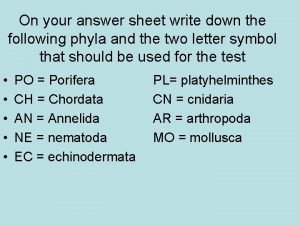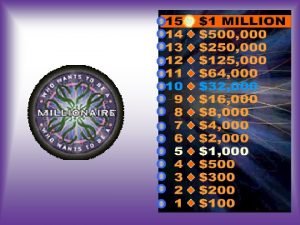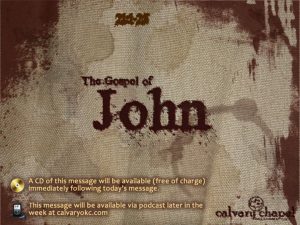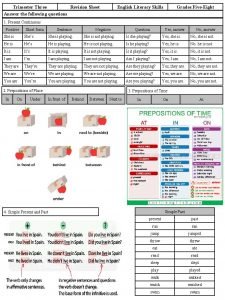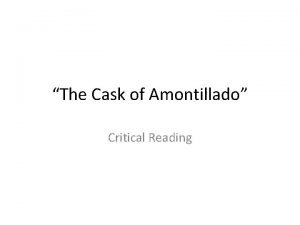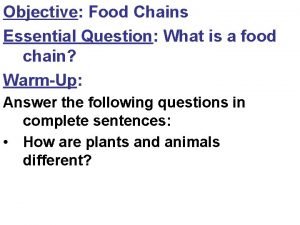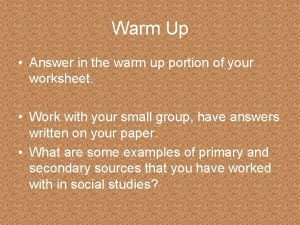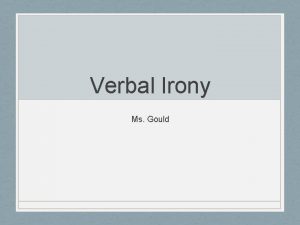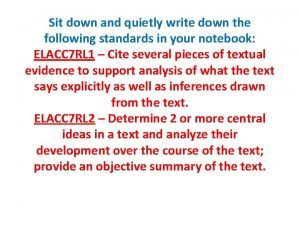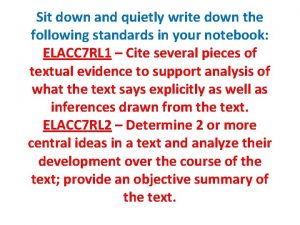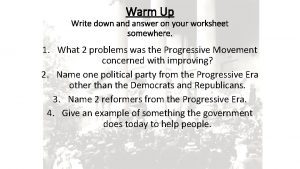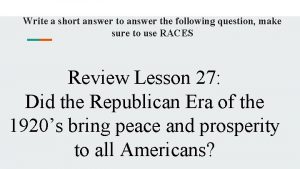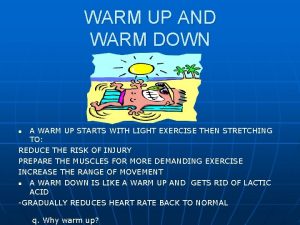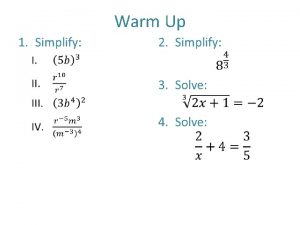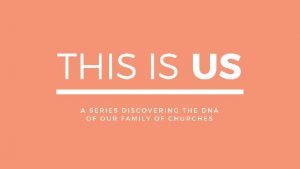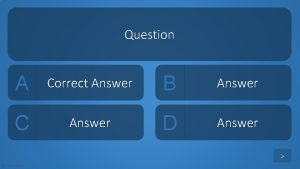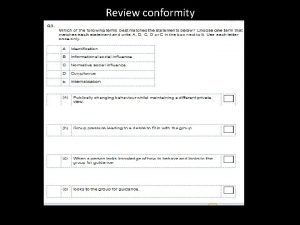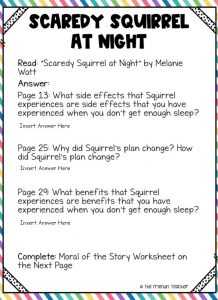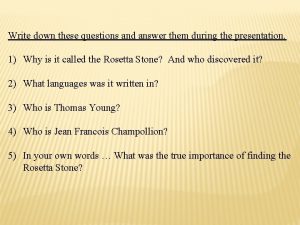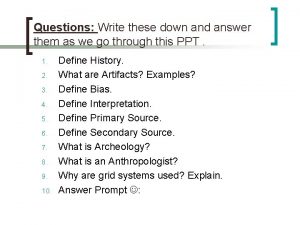Warm up Write down and answer the following





















- Slides: 21

Warm up: Write down and answer the following questions in your notebook: • Which crop greatly increased the need for slave labor in the American South? • What kinds of laws did states create in order to enforce/maintain the system of slavery?

Slavery and Inequality in the US Unit notes, get out your notebook!

Triangular Trade http: //www. youtube. com/watch? v=jd 4 r. Rp 48 wcg http: //www. youtube. com/watch? v=z. Y 5 Hq 2 B 4 r. M&feature=related

Unit Essential Questions • -What is the history and context of slavery in the United States and around the world? • -What was life like for slaves? What were forms of resistance and who was involved? • -Does slavery affect us (either positively or negatively) or is it still present in any form today?

Learning about Slavery • http: //www. youtube. com/watch? v=h. Y 6 Ax. Ek. VF _8&feature=BFa&list=ULjd 4 r. Rp 48 wcg&lf=mfu _in_order

Slavery Timeline • 1502 First reported African slaves in the New World • 1803 Denmark is first to ban the slave trade. • 1807 The United States passes legislation banning slave trade that will take effect the following year.

Timeline continued • 1860 s The Atlantic slave trade was abolished over a 30 -year period ending with Portugal’s 1836 ban on slave trading. But legal abolition did not end the still profitable trade. It continued illegally well into the 19 th century. As long as there remained a market for slaves in the Americas, mostly in Brazil and Cuba, the trade would continue until the 1860 s.

Development of a slave labor based economy in the South • Cotton was a cash crop that required a lot of labor, and was very profitable, especially after the invention of the cotton gin: - As cotton production expanded, demand for slaves also rose - This also drove planters west to find new land for growing cotton The Southern economy was still based on agriculture, and urbanization and industrialization developed more slowly than in the Northern states.

Slave Concentrations in the US

Slavery in the Constitution • You tell me: What was the 3/5 ths Compromise? • Your answer from yesterday- why didn’t the founding fathers end slavery when they were drafting the constitution?

Northern and Southern Views on Slavery • By 1800 there were about 50, 000 slaves in the North - compared to 1 million in the South • Most white northerners still viewed African Americans as inferior, and the laws still severely limited the rights of free African Americans in the North. • Not all northerners wanted to end slavery, but a small minority did- they were called abolitionists. Northern bankers, merchants, and some workers generally opposed ending slavery.

Compromises to save the Union? • • Missouri compromise 1820 Compromise of 1850 Fugitive Slave Act Kansas-Nebraska Act 1854

The Missouri Compromise 1820 • Slavery prohibited in the Louisiana territory north of the 36 60’ line, except in Missouri • Maine enters the union as a free state • Missouri enters the union as a slave state • Significance: the compromise preserved the balance of free and slave states in the Senate. However, it marked the beginning of the sectional conflict that would lead to civil war.

Missouri Compromise

Compromise of 1850 • California enters as a free state • Slavery issue to be decided by popular sovereignty in Utah and New Mexico territories • New, stricter Fugitive Slave Act • Slave trade but not slavery is ended in Washington DC • Significance: This compromise was not a good solution to the sectional conflict because it pushed many people to more radical positions.


Fugitive Slave Act • The law that required all citizens to aid in catching runaway slaves. • If you helped a fugitive slave you could be fined or imprisoned. • Review: http: //www. youtube. com/watch? v=w. Za. FJMCMbs

Kansas-Nebraska Act 1854 • Created potential for slavery in Kansas and Nebraska territories by allowing for popular sovereignty • Caused violence between pro and anti slavery groups as they fought for control- “Bleeding Kansas” • Significance: This overturned the Missouri Compromise. Although it was meant to unite the nation, it caused further division and led to the creation of the Republican Party.


Resistance and Revolt • Abolitionists, slaves, and freed African Americans resisted in many different ways. • Passive Resistance was a method used by slaves to resist their servitude. . How might slaves passively resist? • Active Resistance was another method also used- this is the more classic violent revolt, or abolitionists campaigning for their cause, giving speeches, writing for newspapers…

Nat Turner’s Rebellion I have a short reading on Nat Turner’s Rebellion You can either read it by yourself or with a partner. But please read it and answer the following question: Was Nat Turner’s Rebellion successful? Why or why not?
 Answer the following on your answer sheet
Answer the following on your answer sheet Type your answer here.
Type your answer here. 2 read and answer. write in your notebook
2 read and answer. write in your notebook In your notebook answer the following
In your notebook answer the following I fled him down the nights and down the days
I fled him down the nights and down the days Warm up domain range and functions worksheet answers
Warm up domain range and functions worksheet answers Trimester fill in worksheet answers
Trimester fill in worksheet answers When montresor offers the medoc wine to fortunato
When montresor offers the medoc wine to fortunato Let this place erupt with praise
Let this place erupt with praise Hands on your hips
Hands on your hips There's a place where mercy reigns and never dies
There's a place where mercy reigns and never dies Why doesn’t air pressure crush your desk?
Why doesn’t air pressure crush your desk? Decomposer
Decomposer Motion graphs warm up answer key
Motion graphs warm up answer key Warm up answer
Warm up answer Verbal irony cartoon
Verbal irony cartoon Warm up to irony answer key
Warm up to irony answer key Hát kết hợp bộ gõ cơ thể
Hát kết hợp bộ gõ cơ thể Lp html
Lp html Bổ thể
Bổ thể Tỉ lệ cơ thể trẻ em
Tỉ lệ cơ thể trẻ em Chó sói
Chó sói
